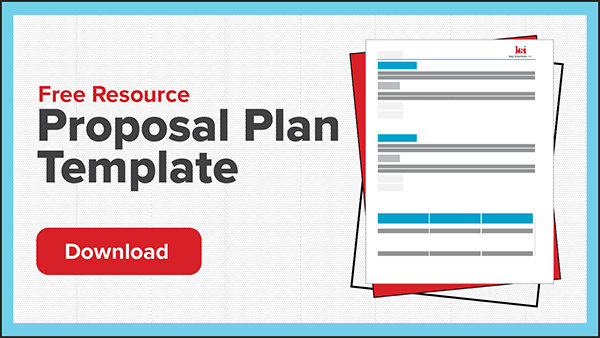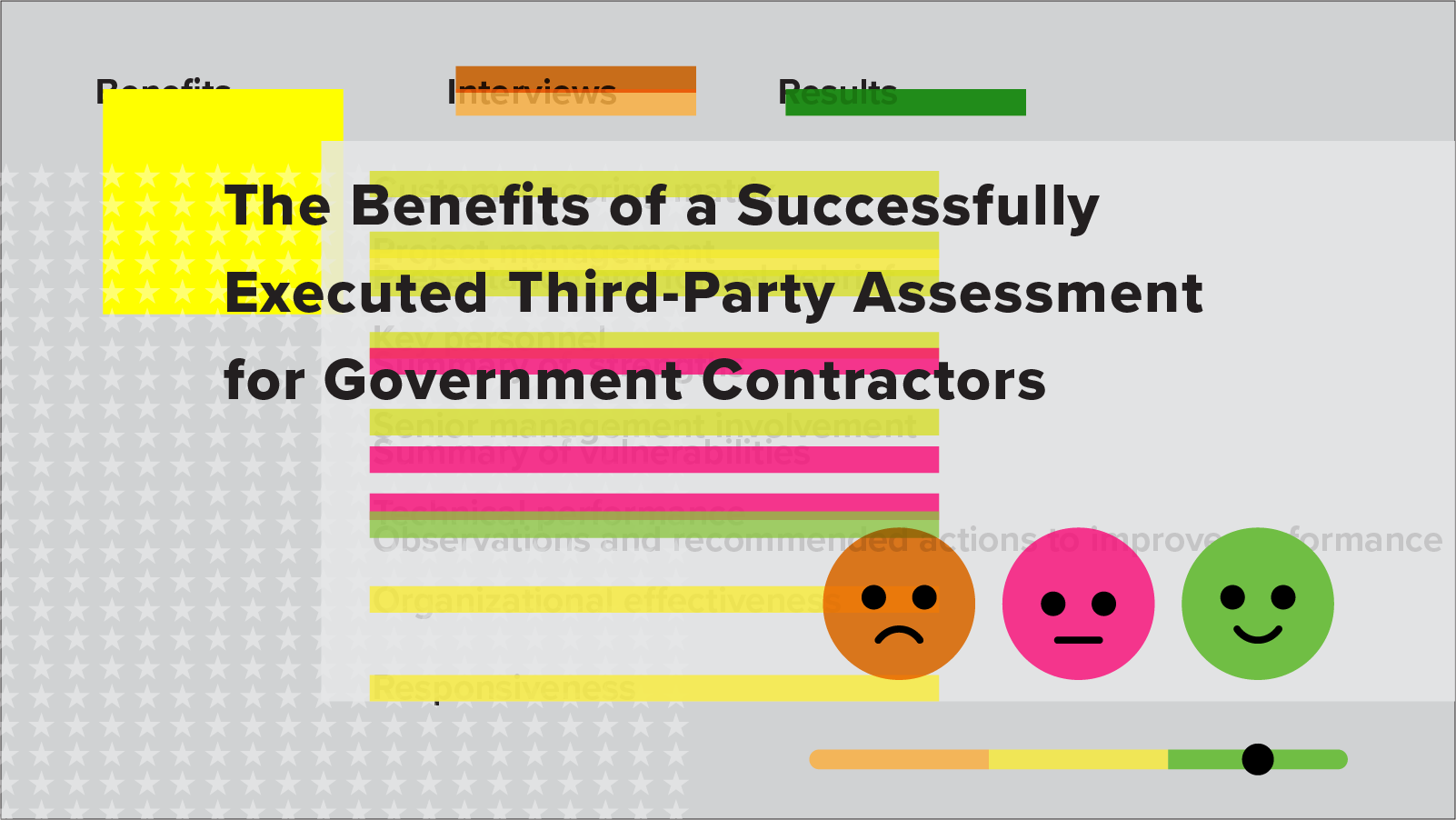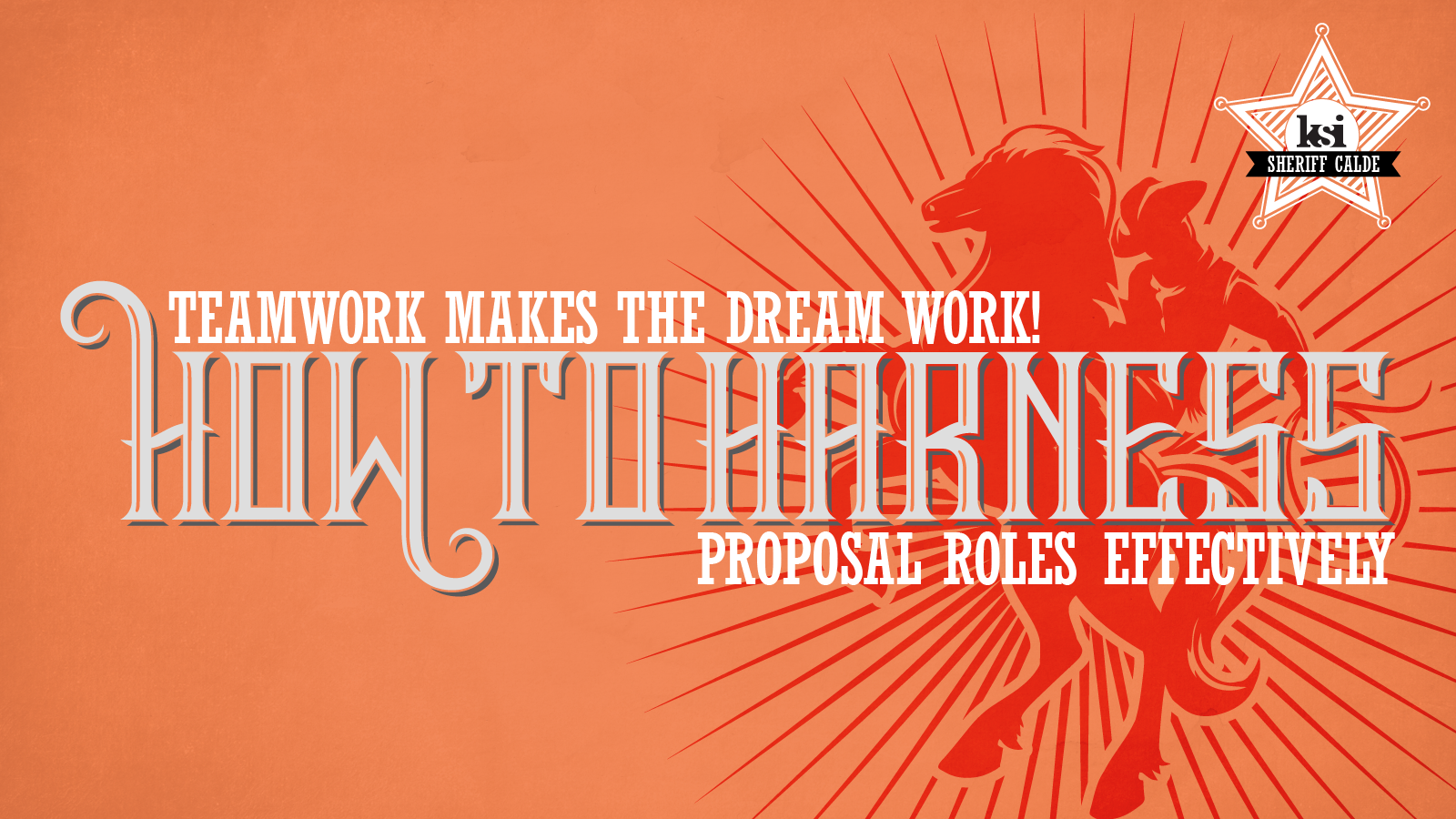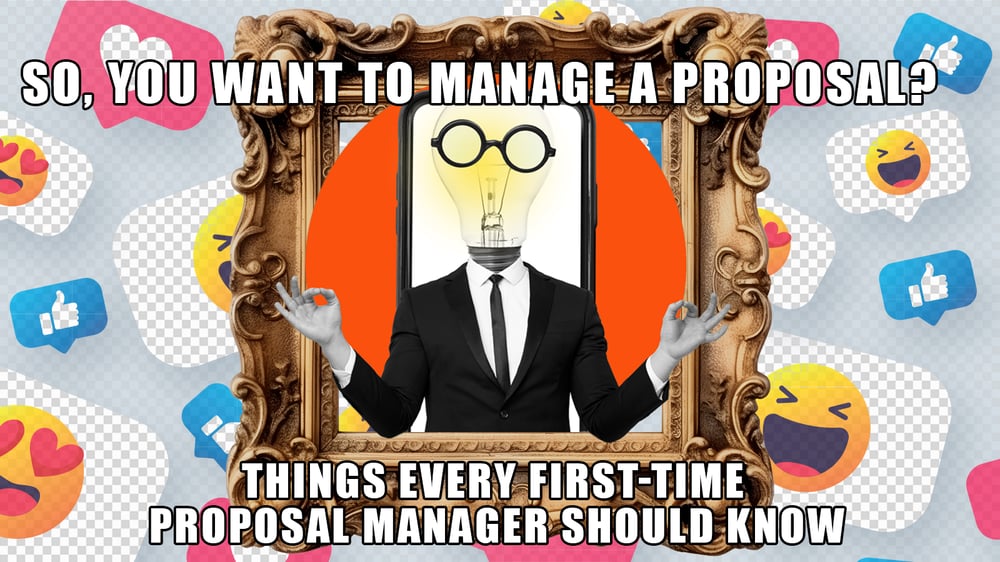
Stepping into a Proposal Manager role for the first time can be overwhelming and intimidating. Many proposal professionals learn on the job or through a trial-by-fire scenario. The “this is fine” meme comes to mind.
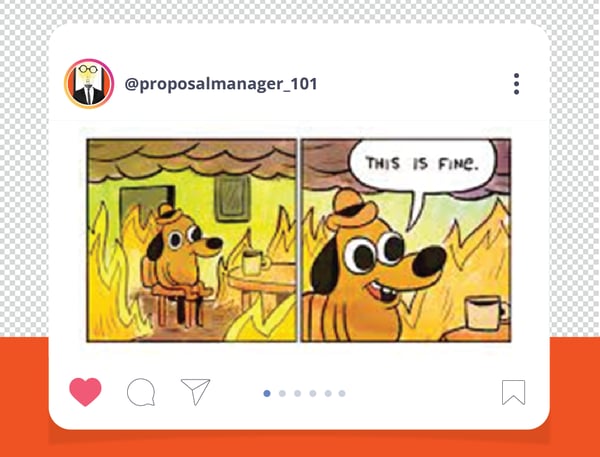
Credit: KC Green's web comic strip "On Fire."
It is not as common as we'd like that people receive formal training before stepping into a proposal role, and even less common that people go to school specifically for proposal development and management. Even though there are universities that offer technical rhetoric and federal contract courses—like James Madison University and George Mason University—there are few folks in our industry who knew in college they wanted to pursue proposals and government contracts for a living. Many of us stumble upon proposal development as a career path.
This article focuses on the foundational responsibilities and best practices that are helpful for a first-time Proposal Manager:
- Get it started
- Keep it going
- Submit it
- Update the process

While parts 1 through 4 focus on the activities and responsibilities associated with proposal management, areas like organization, communication, and compliance are major factors of proposal management to keep in mind during each part of the proposal development process.
It is important to stress that ensuring compliance is a key responsibility of the Proposal Manager. Depending on your organization, the formal responsibility of compliance management and reviews may fall into a separate role. Having an independent compliance lead is considered a best practice. And even if compliance is overseen by someone else, the Proposal Manager must still understand the requirements and maintain compliance of the proposal. A non-compliant proposal will not win, so the Proposal Manager can minimize the risk of non-compliance by building the requirements into the outline and writing templates. Creating an outline that follows the response structure in the solicitation and incorporating the requirements into the writing template helps set your team up for success.
1. Get it Started: What do I do when a final RFP is released?
There will be a Bid/no-bid decision. Did your team decide to pursue this opportunity? If you have the green light, it’s time to:
- Shred the RFP: The phrase “shredding an RFP” refers to reading and digesting the full RFP, requirements, and associated attachments. When you understand the RFP and its requirements, you are able to develop important deliverables to lead the proposal. These include:
- Prepare a proposal calendar: Create a schedule based on the proposal submission date to help the team stay on track and submit on time. On each proposal, there are important dates to consider: Kickoff meeting, Questions due date, regular status calls, Storyboarding, writer pens down deadlines, Color Team Reviews, writer recovery windows, final editing, final desktop publishing, sign-off, final production (if required), and submission.
- Develop a proposal outline: The outline is developed based on the Instructions, Evaluation Criteria, and Scope sections of the RFP. Using these requirements, the outline of the response will not only align with the RFP and be compliant, but it will also make it easier for Evaluators to review and score the proposal.
- Develop a compliance matrix: The compliance matrix enables the Proposal Manager to oversee and ensure the compliance of the proposal. The compliance matrix is not just a tool for the Proposal Manager, it is also an important tool for writers, reviewers, etc. Understanding and ensuring compliance during writing and review cycles helps the team be sure each section meets requirements. It is important to maintain compliance throughout the proposal development process, not just a quick confirmation at the end.
- Set up and run a kickoff meeting: The Kickoff meeting helps everyone participating in the proposal start on the same foot, understand the background of the opportunity, and head in the same direction with their assignments.
- Develop annotated outlines/shell documents for the proposal team to begin writing: Using the outline and the compliance matrix requirements, the Proposal Manager can develop annotated outlines within the writing templates for the writers. The annotated outlines include the headings of the proposal that follow the outline, and the requirements for each section of the proposal are inserted into the template underneath their associated heading. This helps the team understand which requirements should be addressed or written to under each proposal heading.
- Set up a workspace: Create a secure, virtual workspace to develop the proposal. Many proposals are managed and written amongst remote team members. A virtual space provides an environment where everyone can work online, save their work in a communal place, see the latest version, and measure progress. All these things help create a more efficient and collaborative team. Commonly used virtual workspaces include Microsoft Teams, SharePoint, Privia, DropBox, RFPIO, Trello, Asana, and more. A virtual workspace not only helps team members collaborate, but it also allows the Proposal Manager to stay organized because all the proposal resources are in one place. This makes it is easier to keep a pulse on all proposal activities and progress.
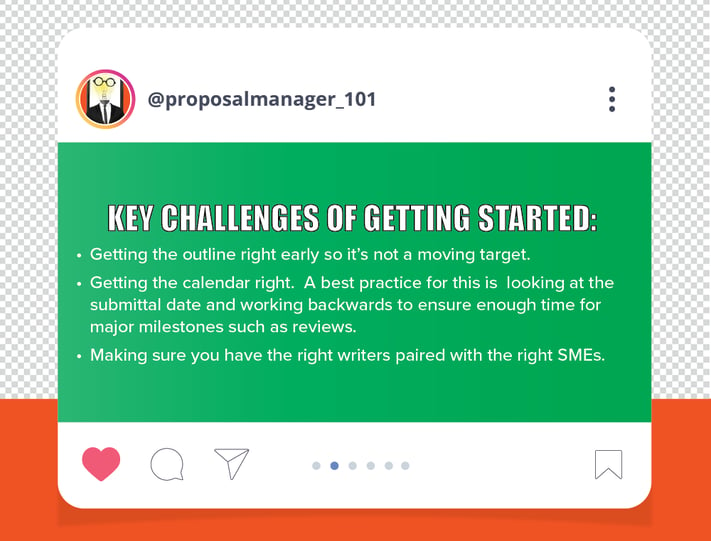
2. Keep it Going: Once you have kicked off the proposal and created your deliverables, how do you run things?
- Conduct status calls and regular touch bases with all team members: Regular communication during proposal operations helps keep things on track. By hosting and communicating together as a team, the Proposal Manager can maintain the schedule, address challenges, and find the resources needed to help the proposal team – whether that’s people, tools, or both. Depending on the timeline of the proposal, status calls two or three times a week may be sufficient, or if you are working on a very condensed timeline, daily status calls may be needed.
- Depending on how big your team and proposal are, have status calls with just the proposal team to ensure everything is on schedule and running smoothly: With an extremely large team, it may be more efficient to have calls between smaller groups. For instance, bring the writing team and SMEs together more regularly, while the decision makers can attend weekly calls with Volume Leads. Between the Volume Leads and Proposal Manager, the information discussed with the decision makers will be disseminated across the writing team.
- Proposal reviews – Prepping and running Color Team Reviews: It is considered a best practice to have a minimum of three Color Team Reviews – Pink, Red, and Gold. Depending on the response timeframe, you may only have enough time to work in two Color Team Reviews. As the Proposal Manager creating the schedule, you’ll have to use your best judgment as to how many reviews are appropriate based on your timeline. An easy rule of thumb to follow for scheduling reviews is two reviews for a 2-week response; three reviews for a 3-week to 4-week response. If your proposal has an 8-week response timeline or longer, you can work additional review cycles into the schedule, but the bulk of the additional time should be spent on writing and recovery between reviews.
- Editing, Desktop Publishing (DTP), and graphics – Keep up with it throughout the bid, not just at the end: Build in editing and DTP cycles throughout the proposal schedule. It is considered a best practice to perform an edit, DTP, and insert all the latest versions of graphics before each review cycle so reviewers see the document at its current best. Minor mistakes such as formatting and/or spelling errors can be distracting to reviewers and prevent them from focusing on the content and providing guidance to the writers. An edit and DTP pass before each review can help avoid such distractions for the reviewers.
- Identifying gaps early and addressing them ASAP – Gaps should not wait to be shared during the first review cycle (Pink Team Review): If there are gaps within a section or areas where writers are not able to address requirements, that is an issue that needs to be brought to the Proposal Manager’s attention immediately so the Proposal Manager can identify the appropriate support to resolve those gaps. For gaps that cannot be resolved prior to Pink Team, it is important to leave notes throughout the document where the gaps are present, as well as communicate the gaps to the reviewers and appropriate decisionmakers prior to the review. This helps the reviewers prepare and focus their attention during the review on significant content or solution holes in need of their input.
- Compliance checks – During the Color Team Reviews, a separate compliance review should be performed by the Proposal Manager or a Compliance Manager for the entire proposal: All non-compliant items should be noted and shared with the writers during the recovery cycle to make corrections and address the requirements. The writers should inform the Proposal Manager or Compliance Manager once their non-compliant items have been addressed. At a minimum, all non-compliant items should be resolved before the next review cycle. If it is not possible to resolve those items, they should be clearly noted as gaps (highlighted and noted in red text) in the document and communicated to the reviewers before they perform their review of the proposal. Again, by informing the reviewers in advance, they can help address the gaps or identify the appropriate person to address the gaps. This will also help them focus their review time appropriately.
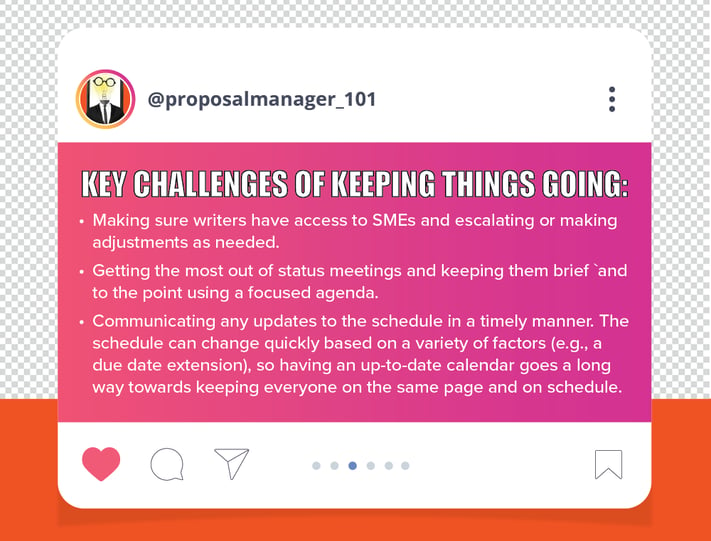
3. Submit it: The proposal due date is upon us! Remember to check off the following items before you submit the proposal:
- Final compliance check: The Proposal Manager and/or Compliance Manager will perform a final compliance check of the entire proposal. Once the compliance check has been performed, no major rewrites of the bid should occur. If rewrites are necessary, the Proposal Manager or Compliance Manager will have to review the adjusted sections again for compliance.
- Final editing and conventions check: During the final edit of the proposal, the editor will check for grammar, readability, consistency, and one voice. The consistency and one-voicing include a conventions check so all sections read the same and use similar language/terminology. Conventions help multiple writers cohesively develop content and prevent a proposal from feeling disjointed when you read section to section.
- Final formatting and DTP: Once changes and final polishing of content are complete, the Desktop Publisher will perform a final DTP of the entire proposal to ensure the formatting is compliant and consistent across all sections and volumes. This also includes file names and formats.
- Quality check: Perform a quality check of all the details, overall formatting, headers and footers, callout boxes, and graphics. It can be helpful to PDF (or even print) the document and review it that way, because looking at the document in a different format/medium can help you identify inconsistencies you hadn’t noticed before.
- White Glove: This is the final review of the proposal. Depending on the type of submission (electronic of hardcopy) or your company’s SOPs, you can perform a White Glove review via PDF or by printing the final proposal and turning it page by page. This page-turn review focuses on glaring errors and “deal breakers.” This is not another opportunity to make “happy to glad” changes, but instead to notice any blatant errors in data points, page numbers, reference numbers, etc.
- Sign-off: Once the White Glove is complete and any glaring errors found have been corrected, the proposal will go to the final sign-off POC. That is usually the person responsible for the submission and quite literally signing the bid.
- Production (if a physical hardcopy submission): When a physical production or print is required, the Proposal Manager will oversee the printing process for all the binders and volumes of the proposal. The printed proposal will be worked into the White Glove and sign-off process above.
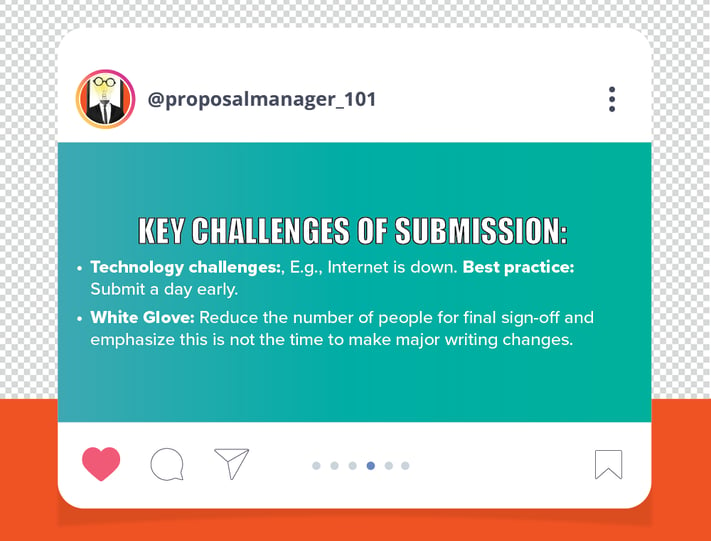
4. Update the Process: Once you’ve submitted the proposal, one does not simply move on and forget it. What are the post-submission activities that help set you up for success on the next bid?
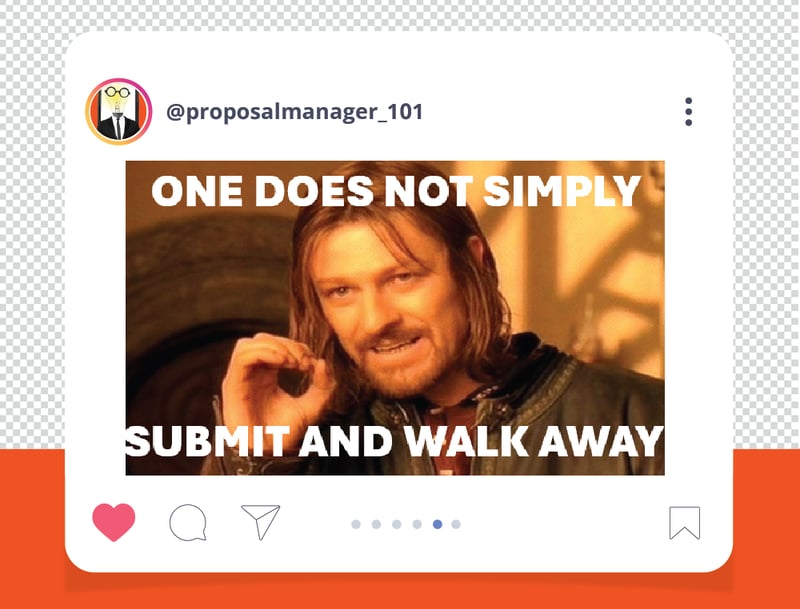
By taking care of the following “close-out” tasks, you will help your team be much more organized when working on the next proposal.
- Lessons learned: Host a meeting to share feedback, areas for improvement, and the lessons learned by the team.
- Content repository/library: Save or upload your final submission documents and other appropriate files to your content repository or library so they are easy to locate and share on the next proposal.
- Update templates and tools based on the flow of the last proposal and feedback from the team: Using the feedback from the lessons learned meeting, update appropriate tools, templates, and SOPs so the next active bid is a smoother execution and that much easier for all participants involved.
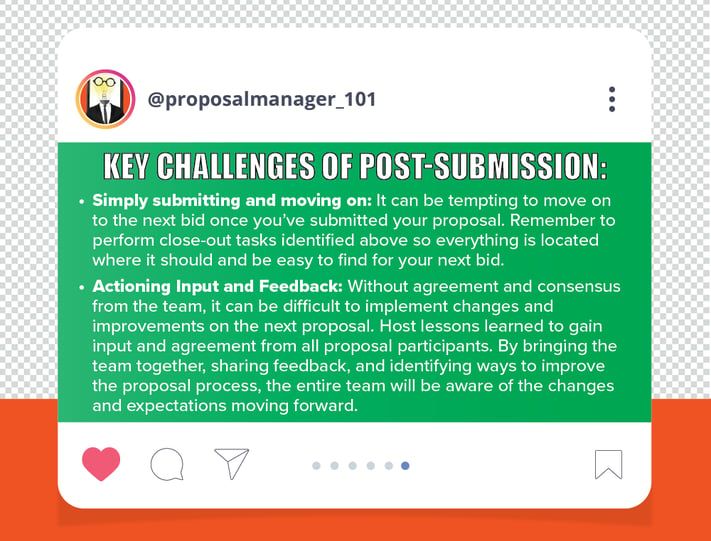
Conclusion
Success in a Proposal Manager role does not correlate only to wins. Of course, wins are the ideal result, but to be successful, it is important to manage compliance, remain organized, and communicate clearly and proactively with the team. Proposal Managers who focus on these items throughout the proposal development process have the best chance of achieving a contract award because a compliant, compelling proposal is one step closer to being a winning proposal.



